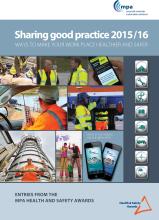The UK’s
MPA’s SD reports aim to further improve the quality and reporting of sustainability data to achieve more transparency and better communication of sustainability.
Nigel Jackson, chief executive MPA, said: “Against the continuing difficult economic backdrop, which sees the industry now operating at the same market levels as in the mid-1960s, these reports demonstrate the industry’s continuing commitment to sustainable development, illustrate the progress we have made and set out the challenges we still face. Our aim is to rise to these challenges and deliver sustainable development.”
MPA SD Report
MPA’s 4th SD Report highlights that the mineral products industry, with an annual turnover of £9 billion (€11 billion) and supplying industries with a combined turnover of £400 billion (€492 billion), makes an essential contribution to national and local economies, the UK economy and its sustainability.
However, with the identifiable costs and burdens of environmental and planning regulation on the industry currently around £400 million/year (€492 million), while supporting high operating and sustainability standards, MPA believes that regulation to encourage sustainable development is reasonable, proportionate, consistent and effectively implemented.
Highlights from the MPA SD Report include further improvements in industry health and safety supported by award-winning MPA initiatives; new policy and initiative to improve the safety of vulnerable road users; continuing reductions in industry carbon emissions (cement emissions down 55% since 1990), and increasing focus on the contribution concrete construction can make to reducing energy use and carbon emissions during the operational life of buildings.
Further highlights are that delivery of 20% of aggregates and 19% of cement are made by non-road modes; 29% of the British aggregates market is supplied by recycled and secondary materials (over twice as high as the European average); 40% of fuel used for cement manufacture comes from waste-derived sources, and improving biodiversity and nature conservation remain key industry objectives supported by broader liaison with conservation bodies.
BLA SD Report
The second report from the British Lime Association (BLA) incorporates data from BLA’s three associate members. This increased coverage means that a more accurate picture of lime production can be presented.
Another significant development since the last report is the formulation of the
Highlights from the BLA SD Report (2005-2011 comparison) show that total CO2 emissions/tonne of high calcium lime manufactured reduced by 11%; SO2 emissions/tonne of high calcium lime manufactured decreased by 78%; SO2 emissions per tonne of dolomite manufactured decreased by 20%; point source dust emissions/tonne of high calcium lime manufactured decreased by 39%, and point source dust emissions/tonne of dolomite manufactured reduced by 77%.
Waste sent to landfill has been reduced by 94% per tonne of lime manufactured; waste derived material made up 36% of combustion fuel used for dolomite production while environmental incidents reduced by 60%.
BMAPA SD Report
This is the marine aggregate sector’s 6th sustainable development report. Under this initiative, BMAPA continues to publish a wide range of data to provide a comprehensive measure of the sustainable development performance of the sector as a whole.
Major national construction projects such as the 2012 Olympic Park, Crossrail and the Thames Tideway Tunnel serve to demonstrate the crucial role that marine aggregates play in our everyday modern life. In supporting these demands, the marine aggregate sector needs the ability to access extremely localised, economically viable marine sand and gravel deposits.
Highlights from the BMAPA SD Report show that the area of seabed licensed for dredging reduced by 1.3% to 1,274km² and hours dredged increased by 13.2% to 18,841 hours; regional environmental assessments now completed in four regions in support of a licence renewal programme, while total CO2 emissions increased by 13.8%, emissions per tonne landed decreased by 3.8%.
The BMAPA produced 14 electronic member alerts as part of an extensive health and safety programme.
Download the MPA SD Report here:
%$Linker:
Download the BLA SD Report here:
%$Linker:
Download the BMAPA SD Report here:
%$Linker:





